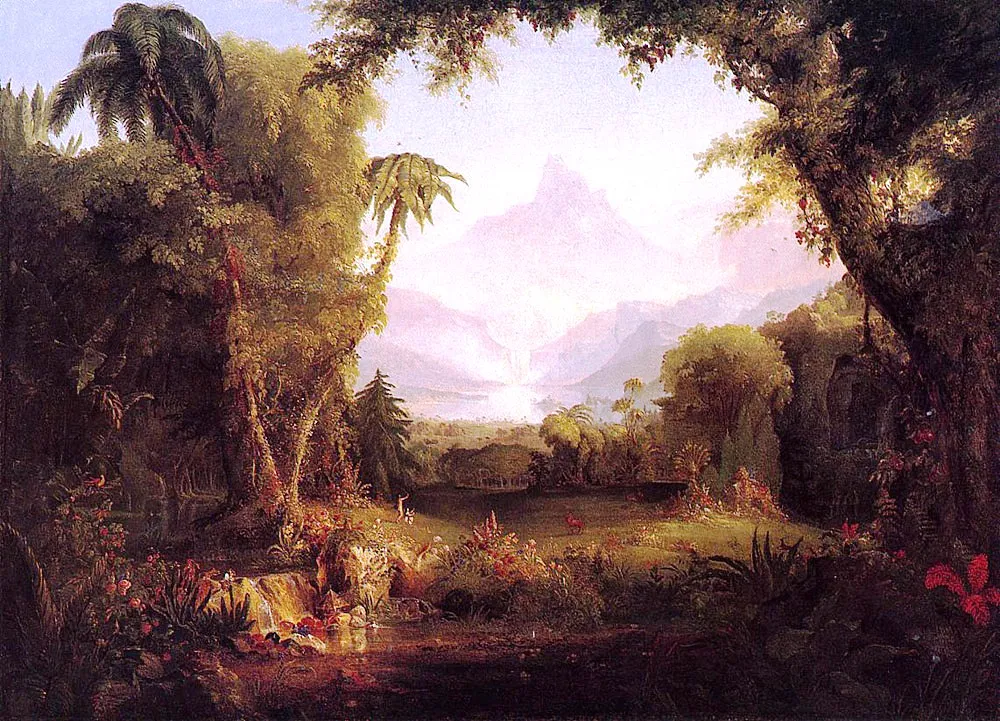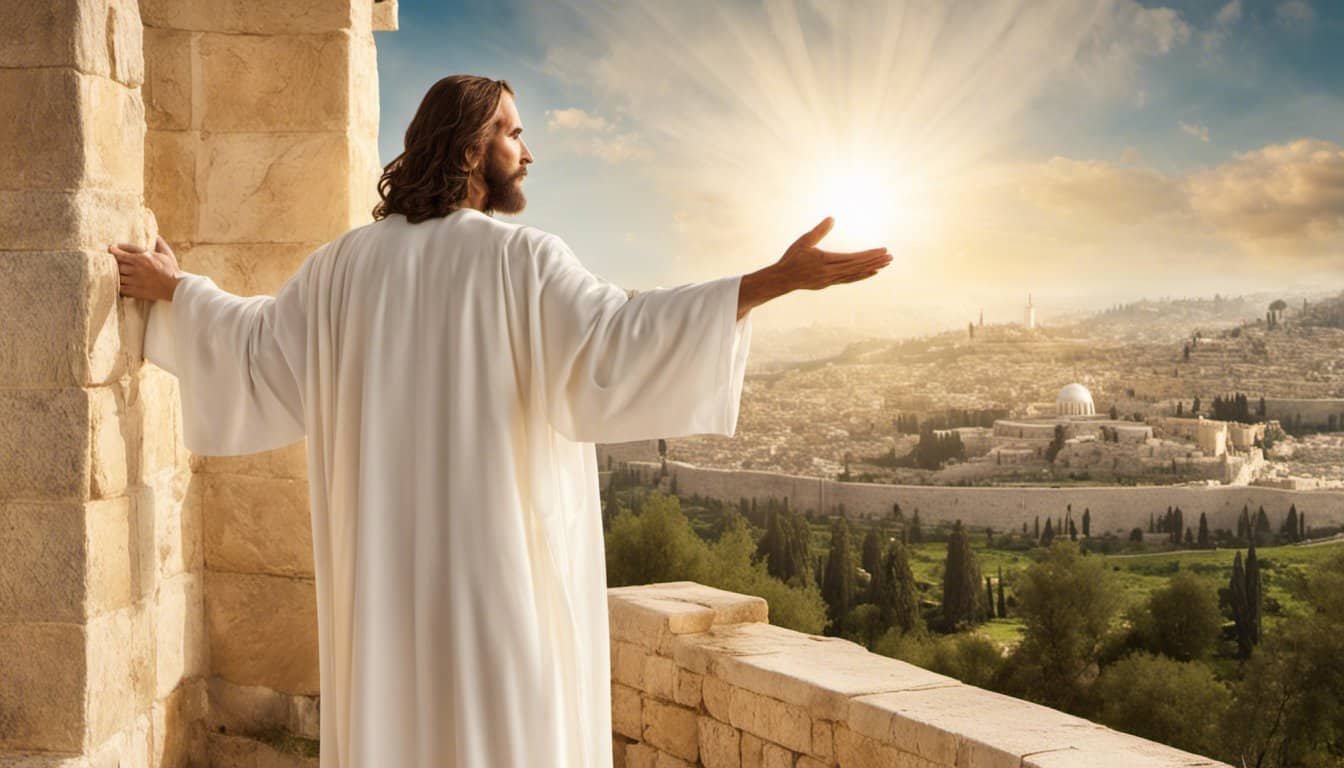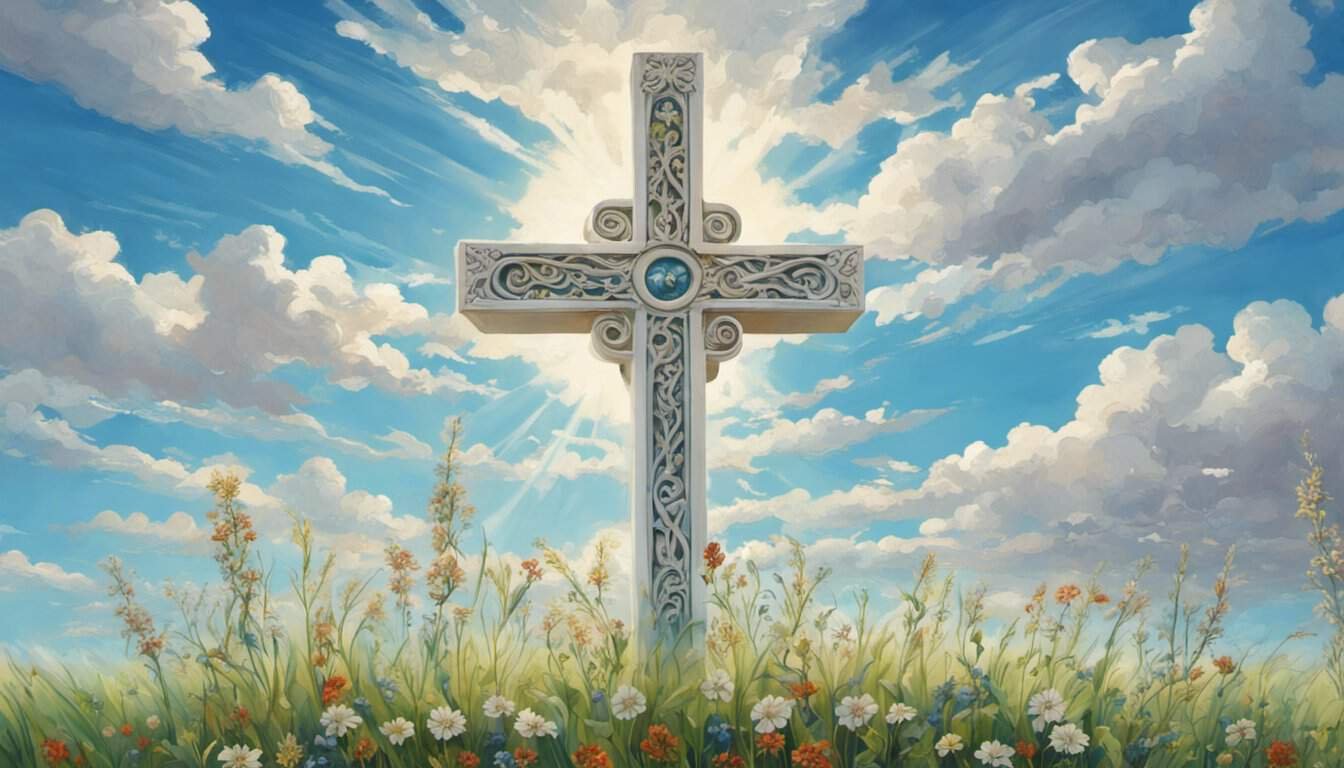Many people have wondered what the Garden of Eden in the Bible was like, but little is known about it apart from the biblical account of Adam and Eve and the Tree of Knowledge. In this post, we will take a deeper look into the story and try to imagine what this paradise might have been like. Join us as we explore the mysteries of this ancient land.
The Garden of Eden in Scriptures

When it comes to discussing the Garden of Eden, it’s impossible to ignore the role it plays in religious texts, particularly in Christian scriptures. The concept of Eden is introduced early on in the Bible, in the Book of Genesis, as a place where God created the first humans, Adam and Eve.
As the story goes, God created Eden as an idyllic, utopian paradise, filled with beauty, harmony, and peace. It was a place where God and his creations could coexist in perfect harmony, and where every aspect of nature was unspoiled and pristine. Some even describe it as a mythical, surreal, and heavenly place, filled with all sorts of beauty that defies description.

As the story goes, Adam and Eve were created fairly quickly into the existence of Eden, after God created the Garden out of the dust of the earth and breathed life into the world. They were tasked with tending to the Garden and living in harmony with the other animals and plants that lived there.
Perhaps the most famous part of the Garden of Eden story is the Tree of Knowledge. According to the Bible, God told Adam and Eve not to eat the fruit from this tree, as doing so would lead to their demise. However, the serpent, who represents temptation and evil, convinced them to eat the forbidden fruit, which led to the fall of man and the loss of innocence.
Many scholars and theologians believe that the story of the Garden of Eden is an allegory for the creation of the world, but it’s also used as a way to explore the concept of original sin in Christianity. Original sin is the idea that all humans are born inherently sinful and corrupted, thanks to Adam and Eve’s disobedience in the Garden.
Overall, the Garden of Eden serves as an important aspect of Christian mythology, and its description as a peaceful and idyllic paradise is an idealistic representation of God’s desire for creation. While it may be a mythical place, it continues to hold an important place in Christian culture and remains an iconic and picturesque representation of paradise.
In summary:
- Eden is introduced in the Bible as a utopian paradise created by God.
- Adam and Eve were created to tend to the Garden and live in harmony with nature.
- The Tree of Knowledge represents temptation and leads to the fall of man and the concept of original sin.
- The Garden of Eden is an allegory for the creation of the world and the concept of original sin in Christianity.
- The mystique of Eden continues to hold an important place in Christian culture and is an idealistic representation of God’s desire for creation.
What Was Eden Like?
Close your eyes and imagine a place where every single one of your needs is met. The temperature is just right, and the weather is perfect for a picnic or a stroll through the gardens. The smell of fresh flowers and fruit trees fills your nostrils, and the sound of birds chirping and leaves rustling in the breeze soothes your soul. You’re surrounded by beauty, peace, and harmony. In your mind’s eye, you see waterfalls, rivers, and streams, winding their way through lush vegetation, and at the heart of it all, the Tree of Life, towering above everything, it’s fruit promising eternal life. Can you see it? That’s the Garden of Eden.
According to Biblical scriptures, the Garden of Eden was the home of the first humans, Adam and Eve, created by God in his image. It was a beautiful, idyllic, utopian paradise, where everything was in perfect balance, and every creature lived in perfect harmony. Adam and Eve were created to live in the garden, to tend to it, and to enjoy all that God had given them.
The creation story in Genesis tells us that the Garden of Eden was a divine creation, the pinnacle of God’s work. It was a place of immense beauty, with trees, plants, and flowers that defied description. The sky was always blue, and the sun always shone. The air was warm, and the water was pure. It was a surreal, unspoiled, and pristine place, where everything was perfect.
One of the most famous features of the Garden of Eden was the Tree of Knowledge of Good and Evil. The Bible tells us that God warned Adam and Eve not to eat the fruit from this tree, or they would surely die. However, the serpent, who was described as the most cunning of all creatures, convinced Eve to take a bite of the forbidden fruit. She then shared it with Adam, and their act of disobedience led to the fall of man and the introduction of sin into the world.

The story of the Garden of Eden is rich in symbolism and metaphor, and there are many different interpretations of what it represents. Some people believe that it was a literal, historical place, while others see it as a mythical or allegorical representation of humanity’s lost innocence and the desire for a return to paradise. Regardless of how you interpret the story of Eden, there is no denying that it represents a yearning for a better world, a more peaceful and harmonious existence.
In summary, the Garden of Eden was an idealistic, heavenly, and mythical place, held in reverence by many who follow the Creation story. Its beauty and perfection have been lost to humanity because of our actions. The story of the Garden of Eden reminds us that there is a high price to pay for our disobedience and that we should always strive to live in harmony with one another and our environment.
The Story of Creation
Imagine a world without pollution, pain, or death. A place where everything is in perfect harmony, and animals and humans live together without fear. This is how the Bible describes the Garden of Eden, the birthplace of humanity, and the first home of Adam and Eve.
According to the book of Genesis, God created the world in six days, and on the seventh day, he rested. On the third day, he created the land and sea, and on the fourth day, he made the sun, moon, and stars. The fifth and sixth days were dedicated to animals and humans. On the fifth day, God created sea creatures and the birds of the air. On the sixth day, he made land animals and, finally, humans.
Adam was the first man created, and Eve was the first woman. They were made in the image of God and were given the responsibility to care for the garden. The Bible describes the garden as being perfect, with blissful and idyllic surroundings. The garden was full of beautiful trees, rivers, herbs, and spices. The garden had a tree that was unlike any other, called the tree of knowledge, which was protected and forbidden to Adam and Eve.
The Bible describes Eden as a divine, surreal, and unspoiled creation. It was a utopia, where everything was in harmony and peaceful. The setting and surroundings were pristine, making it a heavenly and picturesque paradise.
« Worshiping Jesus: An Exploration of Faith, Salvation, and Deity
Sowing and Reaping: Exploring the Biblical Perspective on Harvesting Spiritual and Material Rewards »
In summary, the Garden of Eden was a mythical place described in the Bible as the birthplace of humanity. The surroundings were idyllic and utopian, with all creatures living together in harmony. The garden was a place of divine beauty, pristine surroundings, and surreal landscapes. Adam and Eve were the first humans created in the image of God and given the responsibility to care for the garden. The garden had a tree that was forbidden to Adam and Eve, called the tree of knowledge, which they ate from, leading to their fall from grace.
List of Eden’s features:
- The land and sea
- Sun, moon, and stars
- Sea creatures and birds of the air
- Land animals
- Humans
- Blissful and idyllic surroundings
- Beautiful trees, rivers, herbs, and spices
- The tree of knowledge
- Divine, surreal, and unspoiled creation
- Utopian
- Harmony and peacefulness
- Pristine surroundings
- Heavenly and picturesque.
The Tree of Knowledge
In the story of creation, the Garden of Eden is depicted as a blissful, idyllic utopia where the first humans, Adam and Eve, lived in harmony with nature in the presence of the divine. However, the introduction of the Tree of Knowledge changed everything.
The Tree of Knowledge was one of two special trees in the garden, the other being the Tree of Life. The Tree of Knowledge, according to myth, offered the knowledge of good and evil. God had instructed Adam and Eve not to eat from this tree, warning them they would surely die if they did.

Enter the serpent, often depicted as the devil himself, who convinced Eve to eat from the forbidden tree. Eve then offered the fruit to Adam, and they both ate it, resulting in the fall of man and the beginning of the concept of original sin.
The significance of the Tree of Knowledge is highly debated among theologians and scholars. Some argue that the story was never meant to be a literal account, but rather a metaphorical tale meant to teach humans about morality and decision-making. Others interpret the story as a metaphor for humanity’s rebellious nature toward God.
One thing is clear, however: the consequences of Adam and Eve’s actions were dire. They lost their innocence, their harmony with nature, and their paradise in the Garden of Eden. The Tree of Knowledge symbolizes the cost of disobedience and the importance of obeying the divine will of God.
In popular culture and art, the Tree of Knowledge is often depicted as a fruit tree, with the Forbidden Fruit being either an apple or a pomegranate. However, the Bible never specifies what type of fruit it was, further adding to the mystery and intrigue surrounding the Garden of Eden.
Undoubtedly, the symbolism and mythology surrounding the Tree of Knowledge continue to captivate and intrigue people of all backgrounds, making it one of the most fascinating aspects of the Garden of Eden story.

The Serpent and the Forbidden Fruit
Now we come to a critical moment in the story of Eden – the encounter between Eve and the serpent. Genesis 3:1-5 introduces us to the serpent, who is more cunning than any other animal God had created. The serpent approaches Eve and asks her if God had forbidden them from eating any of the fruit in the garden. Eve responds by telling the serpent that they cannot eat from the tree of knowledge, or else they will die. The serpent then tells Eve that she won’t die, but rather that her eyes will be opened, and she will be like God, knowing good and evil.
Eve then considers the serpent’s words and looks at the tree of knowledge. The tree was said to be pleasing to the eye and desirable for gaining wisdom. So she takes some of its fruit and eats it, then offers some to Adam, who also eats it. At once, their eyes are opened, and they realize they are naked. They sew fig leaves together and make coverings for themselves.
The serpent is often seen as a symbol of temptation and evil in Christianity. In interpreting this part of the story, we can see that Eve’s desire for wisdom and knowledge led her to make a choice that went against God’s commandment. This action also led to the original sin and the fall of man from grace, which remains an essential Christian teaching today.
Overall, the story of the serpent and the forbidden fruit serves as a reminder that we must remain vigilant against temptation and be aware of the choices we make. It also shows us that God’s commands are not meant to restrict us but to protect us so that we can live a life that is honorable and pleasing to Him.

To summarize, here are the key points about the serpent and the forbidden fruit:
- The serpent is introduced as the most cunning animal in the garden
- The serpent tempts Eve to eat from the tree of knowledge
- Eve eats the fruit and gives some to Adam, leading to the fall of man
- The serpent symbolizes temptation and evil in Christianity
- The story reminds us to be vigilant against temptation and to follow God’s commands.
In the next section, we will explore the consequences of the fall of man and what it means for the world today.
The Fall of Man
As the story goes in Genesis, God created Adam and Eve in the idyllic and surreal environment of the Garden of Eden. The Garden was a perfect, unspoiled, and pristine place where human beings and animals lived in harmony and peace. The beauty of the Garden was divine and heavenly, and it was an idealistic utopia that was beyond what we can imagine.
However, the Garden of Eden was also the place where humanity experienced its greatest tragedy – the Fall of Man. It was in this lost paradise that Adam and Eve, the first humans, disobeyed God and ate from the Tree of Knowledge of Good and Evil, which God had forbidden them from doing.
The Serpent, who was the most cunning of all the creatures, tempted Eve with the forbidden fruit and convinced her to eat it. Eve then gave some fruit to Adam, who also ate it. Upon eating, they gained knowledge but also a sense of guilt and shame that they had never experienced before.

This event served as the origin of what Christians believe to be the Original Sin, a sin inherited by all humans. It forever altered humanity’s relationship with God and the world, causing them to experience pain, suffering, and death.
The Fall of Man is an essential part of Christianity as it represents the first human rebellion against God’s will. It is also a story of how humanity lost its innocence and the perfect relationship with God, and how it was punished for disobeying the Creator.
What happened in the Garden of Eden is not only a legendary story but also a lesson on the consequences of disobedience and a reminder of the importance of obedience, faith, and trust in God’s will.
Interpreting the myth of the Garden of Eden can be tricky, but Christians believe that it serves as a reminder of the goodness and justice of God and the value of living according to His teachings. The story continues to inspire people today and is a testament to the power of faith and hope, even in the face of adversity.
In conclusion, the Fall of Man represents a turning point in the biblical creation story of Adam and Eve, reflecting both humanity’s failure to remain obedient to God and their subsequent distance from Him. The Garden of Eden was lost, and innocence and harmony were forever disrupted by the Original Sin. Despite all the darkness, the myth of Eden continues to inspire hope and faith, acting as a reminder to live a life of obedience and trust in God.
Interpreting the Mythology of Eden

Interpreting the Mythology of Eden
The story of the Garden of Eden has been interpreted in numerous ways by various people and religious sects over the centuries. Some have taken the story as purely historical and factual, while others view it as a metaphor. Whatever interpretation you believe, everyone agrees that the Garden of Eden was a place of pure bliss, idyllic and utopian, a paradise created by a divine power.
Some see the Garden of Eden as the place where the first humans, Adam and Eve, were created. They were the only people in the paradise, surrounded by pristine beauty and unspoiled nature. Others view the Garden of Eden as a mythical place where everything was heavenly, an idealistic or surreal representation of an unattainable perfection.
The story goes that Adam and Eve were warned not to eat from the Tree of Knowledge of Good and Evil. However, the serpent, the embodiment of evil, tempted Eve, and she took a bite of the forbidden fruit, forcing Adam to follow her lead. From this point on, they were plagued by guilt and shame for their disobedience, losing their innocence and the harmony they once had with one another, with nature and with God.
Some have seen this act as an explanation of the origin of sin and suffering in the world, called the original sin. Others have viewed it as a lesson for human behavior, an illustration of the dangers of temptation and disobedience. Whatever your interpretation, the story of the Garden of Eden remains one of the most important and iconic creations narratives in the history of humankind.

Interpreting the Garden of Eden is an exercise in understanding the values and beliefs of those who created and retold the story over the centuries. Whether it is viewed as a mystical place of beauty or an earthly paradise, the Garden of Eden has captured the imaginations of people across all cultures, religions, and ages.
Here are some ways in which the Garden of Eden has been interpreted over the years:
-
As a representation of the perfect world: The Garden of Eden is often seen as the original perfect world where everything was idyllic and utopian. It was a place of perfect harmony, where all living beings coexisted peacefully.
-
As a metaphor for the relationship between humans and God: For many, the Garden of Eden symbolizes the intimate relationship between humans and their God. It was a place where Adam and Eve could talk to God and enjoy his company.
-
As a lesson on human behavior: The Garden of Eden can also be seen as a cautionary tale about the dangers of temptation and disobedience. It reminds us that we must be vigilant in resisting temptation and staying true to our values and beliefs.
In conclusion, the Garden of Eden has been interpreted in several ways, each reflecting the values and beliefs of the interpreter. It remains one of the most iconic and important creation narratives of all time.












